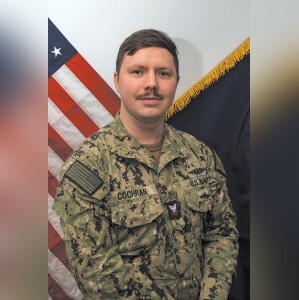|
|

Wayde Cochran Photo by Mass Communication Specialist 1st Class Mitch Meppelink, Navy Office of Community Outreach
KINGS BAY, Ga. – Petty Officer 2nd Class Wayde Cochran, a native of Remington, Indiana, serves the U.S. Navy assigned to Submarine Readiness Squadron (SRS) 36, homeported at Naval Submarine Base Kings Bay. As a submariner, Cochran is part of a small percentage of Navy personnel continuing a 125-year tradition of service under the sea to help ensure Americans’ safety.
Cochran graduated from Tri-County High School in 2017.
The skills and values needed to succeed in the Navy are similar to those found in Remington.
“I learned how to work hard and have a can-do attitude from working the farm through hot summers and frozen winters,” Cochran said. “I’ve learned not to complain about the challenges and to just get the work done.”
Cochran joined the Navy eight years ago. Today, Cochran serves as an electrician’s mate.
“I wanted to get college paid for, and I wanted to be financially independent,” Cochran said. “I liked the challenge that the submarine community offers. I have a lot of family, grandparents and great-grandparents who served in the Navy. I knew when I was in high school that I wanted to join.”
Naval Submarine Base Kings Bay is the homeport of East Coast ballistic-missile and guided-missile submarines. These submarines are capable of conducting operations in the Atlantic, Arctic, Eastern Pacific, and Indian Oceans and the Mediterranean Sea. It is also the only Navy base with the capability to support the Trident II missile, the most sophisticated nuclear missile designed to be launched from a submarine.
Known as America’s “Apex Predators!,” the Navy’s submarine force operates a large fleet of technologically advanced vessels. These submarines are capable of conducting rapid defensive and offensive operations around the world, in furtherance of U.S. national security.
There are three basic types of submarines: fast-attack submarines (SSN), ballistic-missile submarines (SSBN) and guided missile submarines (SSGN).
Fast-attack submarines are designed to hunt down and destroy enemy submarines and surface ships; strike targets ashore with cruise missiles; carry and deliver Navy SEALs; conduct intelligence, surveillance, and reconnaissance missions; and engage in mine warfare. The Virginia-class SSN is the most advanced submarine in the world today. It combines stealth and payload capability to meet Combatant Commanders’ demands in this era of strategic competition.
The Navy’s ballistic-missile submarines, often referred to as “boomers,” serve as a strategic deterrent by providing an undetectable platform for submarine-launched ballistic missiles. SSBNs are designed specifically for stealth, extended patrols and the precise delivery of missiles. The Columbia-class SSBN will be the largest, most capable and most advanced submarine produced by the U.S. – replacing the current Ohio-class ballistic missile submarines to ensure continuous sea-based strategic deterrence into the 2080s.
Guided-missile submarines provide the Navy with unprecedented strike and special operation mission capabilities from a stealthy, clandestine platform. Each SSGN is capable of carrying 154 Tomahawk cruise missiles, plus a complement of heavyweight torpedoes to be fired through four torpedo tubes.
Strategic deterrence is the nation’s ultimate insurance program, according to Navy officials. As a member of the submarine force, Cochran serves aboard a platform capable of bringing the fight to enemies in defense of America and its allies.
The U.S. Navy is celebrating its 250th birthday this year.
According to Navy officials, “America is a maritime nation and for 250 years, America’s Warfighting Navy has sailed the globe in defense of freedom.”
With 90% of global commerce traveling by sea and access to the internet relying on the security of undersea fiber optic cables, Navy officials continue to emphasize that the prosperity of the United States is directly linked to recruiting and retaining talented people from across the rich fabric of America.
Cochran has many opportunities to achieve accomplishments during military service.
“My proudest accomplishment was helping my mentee earn his submarine warfare pin,” Cochran said. “I had a great mentor who helped me through earning my pin, and I’m proud to be able to help the next generation of submariners and encourage them to succeed.”
Cochran serves a Navy that operates far forward, around the world and around the clock, promoting the nation’s prosperity and security.
“Being in the Navy and in the submarine community, you know your shipmates, and you make them your brothers who you don’t want to do life without,” Cochran said. “I feel like the Navy has changed for me over the years. At first, the Navy was just a pathway and a stepping stone to the next chapter, but after reenlisting, I couldn’t imagine not being in the Navy.”
Cochran is grateful to others for helping make a Navy career possible.
“I would like to thank my dad, Todd,” Cochran added. “He always told me that it was a good opportunity for me and that it would help me and keep me invested in my family’s Navy heritage. My dad drove me to the recruiting office himself to show his support for my decision.”

Loading Comments